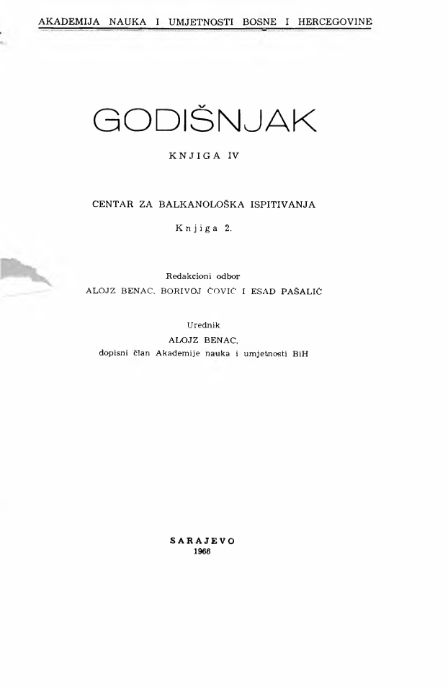Ilirsko pleme Delmati
The Illyrian Tribe of the Delmatae
Author(s): Marin ZaninovićSubject(s): Ethnohistory, Social history, Ancient World, Social development
Published by: Akademija Nauka i Umjetnosti Bosne i Hercegovine
Keywords: The Illyrian Tribe; Delmatae; Dalmatia; social history;
Summary/Abstract: The Delmatae were one of the best known of the numerous Illyrian tribes. They have given the name to the great Roman province of Dalmatia. To-day this name is preserved in the narrow strip of land on the eastern shore of the Adriatic, the modern Dalmatia. The first mention of the Delmatae is by Polybius (32 9 (18), 1—2). In his account, related to the middle of the second century B. C., they are continually molesting the Issaean settlements of Tragurion and Epetion, like their neighbours the Daorsi. So, Issa was forced to send envoys to Rome for protection. The senate declared war on the Delmatae, led by consul C. M. Figulus vho fought them but without final succès. This war was concluded by his colleague P. Cornelius Scipio Nasica who destroyed their main stronghold Delmdnium in 155. B. C. However, this was not the end, but only the beginning of a series of wars and battles with this fierce tribe lasting through one and a half century. Many legions and their eagles were lost in the mountains of the Delmatian land. Only the bloody suppression of the great rebellion of 6—9 A. D. put the end to this long-drawn battle of the Delmatae for their and Illyrian freedom. Only then could begin the real, although mainly superficial, romanization of the vast areas in the interior of Illyricum and surrounding lands. The importance of the Delmatae in the history of Illyricum gives significance to the attempt to delineate their area proper and trace the development of their territory, the themes on which modem authors usually differ. The problem is how deep their area stretched in the interior, how long their coastline was (i. e. from the Titius (Krka) to the Hippus (Cetina) rivers, or from the Titius to the Naron (Neretva) rivers, also, in what period was it held by them. When the Delmatae are first mentioned by Polybius they are not yet present on the coast. They are making incursions in a rich and fertile Manios bay from th e ir mountainous and pastoral interior through the Klis pass. The disappearance of the loose federation of the Ardiaei made it possible for the Delmatae to fill a political vacuum created in the area. The nex t political news about them are by Appianus (111. 11), from the year 119 B. C. when L. Caecilius Metellus had his winter quarters at the then Delmatian town of Salona. This already witnessed their firm establishment in the area. From this point, they were spreading their rule and control towards east and west as fa r as the mouths of the Krka and Cetina rivers. The fact th a t C. M. Figulus was assailing their strongholds in the interior, not frontally from the area of the Manios bay but from Narona, means th a t they were not present in this region. Figulus needed badly a friendly background for his march against them. This he found in the emporium of Narona and in Roman allies the Daorsi to the north of Narona. Important notices on the Delmatae are given by Strabo (VII 5). Their territory is divided in two parts by the Adrion (Dinara) mountain. One is the littoral region and the other extends northwards beyond the other side of the Adrion. Their main port is Salona. Strabo mentions fifty as the number of their major settlements, some of which are the πόλεις. The capital of the Delmatae is Delminium, from which originated the name of the tribe as well. Around the Naron river are the Daorsi, Ardiaei and Pleraei, and there are no Delmatae.
Journal: Godišnjak Centra za balkanološka ispitivanja
- Issue Year: 1966
- Issue No: 4
- Page Range: 27-92
- Page Count: 68
- Language: Serbian

